Comments on RT 1.0
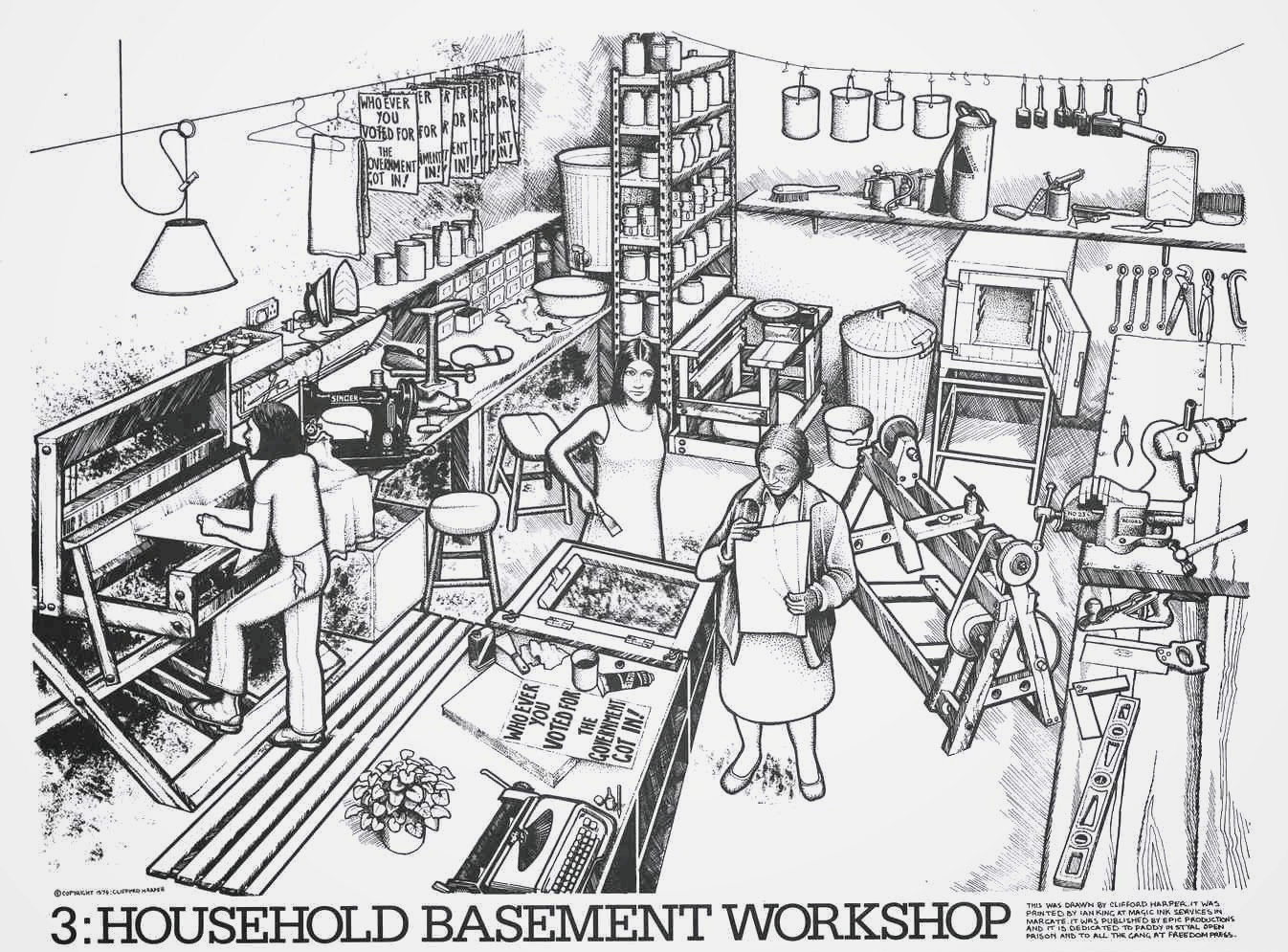
Sandy Irvine
I still have my original copy of RT. I thought the visualisations were very useful. Otherwise it is sometimes not too easy to show what we want. I’ve been building up a selection of relevant artistry and photos of good initiatives I would be pleased to share
Several articles have stood the test of time. I favourite of mine is the one by Brenda Vale. Obviously the ‘resources’ section badly dates but overall it was a milestone publication
Ru Hartwell
A seminal work that I read and enjoyed long before I met you, Peter.
Ian Worrall
I remember radical technology: the line drawings were legendary
Adam Twine
Undies certainly informed my aspirations
Richard Cochrane
Great idea to revisit Radical Technology. I’m very attached to my copy of the book and I’d love to attend the conference in September.
Hugh Barton
…that picture of the terrace was part of the inspiration for UCAT.
Joe Ravetz
… a belated THANKS for producing Radical Technology, with the wonderful drawings, it was a kind of landmark at the time.
Sandy Halliday
A brilliant and timely idea. I must get out my copy
Walt Patterson
I must see if I can dig out my copy of Radical Technology, buriedin my vast and shambolic archives.
Chloe Ward
How I used to love that book! A friend of mine had a copy, and before I started at CAT, we use to pore over it together and dream….
Nick Grant
Book was very influential for me, I used a graph from it when I gave a talk for UN in Gaza! Re read your autonomy article and quoted from it a lot.
John Waters
[Re Cliff Harper’s Visions] Some of those who had never seen his “visions” before were greatly amused to see a woman operating a lathe with naked breasts. Approaches to health and safety have clearly changed a lot over the years.[Comment from Peter Harper: When Cliff drew Class War Comix (before the Visions) he was criticised for the lack of female characters. His response was to go back and undertake some sex-change surgery with his Rotring, which was surprisingly effective. When it came to drawing the Visions, he wasn’t going to be caught out again, so populated his drawings almost entirely with women. Just look! Bare breasts were thought symbolic of liberation. ]
Philip Revell
….information, via Sandy Halliday, about your Radical Technology 2.0 plans. You and Godfrey have a lot to answer for. If it hadn’t been for Godrey’s little book ‘Living on the Sun’ sparking an interest which was then fanned by Undercurrents magazine and then Radical Technology…….
– localism – deep contradictions between rich & poor communities??
– circular economy – captured by corporations??
– alternative tech – small hand built windmills – completely superseded by 100m hi tech turbines??
– steady state economy?? – (a quote from Urban3.0 –
… “It seems not realistic to un-invent global technologies and supply chains: risky to ignore the psychologies of materialism and social hierarchy: and too simplistic that the financial sector can just turn the page and start being more humane. In particular the incredible ingenuity of the modern capitalist economy has to be recognized as an evolutionary process: so if we want to redirect it or restructure it, we need to look for equally ingenious ‘co-evolutionary’ processes and pathways”.
(a) lateral approach with sideways reality checks on apparently great ideas and unintended consequences,
(b) exploration of structural issues on the intersection of lifestyles, technologies, finance etc etc…
(c) just to say the scientific community is more sceptical about eco-footprint, while carbon footprint is more technically defensible. From this angle the footprint agenda is really all about power wealth & inequality, local & global
“Radical Technology” … in February 2016
Chris Butters
Architect, author, lecturer, co-founder of GAIA Norway
10 years in Bhutan
now at Warwick University, researcher in energy/sustainable housing
REVISITING WHERE WE CAME FROM
The late 1960s and early 1970s saw the rise of the environmental movement, and many of the seminal works that indicated a new post-industrial paradigm. Carson, Schumacher, Fathy, McHarg, Commoner, Sessions … the new thinking ranged from practical issues of technology and design, to profound ethical and political ones. It drew on many sources of inspiration, from the Arts and Crafts era (Kropotkin,, Ruskin, Morris, Geddes …) to Oriental philosophy, Gandhian non-violence, and new directions in science (Kuhn, Feyerabend, Capra, etc).
An important strand of this was the Nordic ecophilosophical movement, led by Arne Naess, one of the fathers of Deep Ecology, Sigmund Kvaloy and others.
Just as the Limits to Growth report has recently has its 40th anniversary and a well deserved look back, so there is the anniversary of some key works such as “Radical Technology”.
In Norway, this was one of the works devoured avidly by the “Alternative Technology” student group at the Oslo School of Architecture, led by Howard Liddell as guest professor there in 1979 and for the next four years by Chris Butters. This activity, much hated by most of the professors, also led to the founding of the GAIA architects group, first in Norway and then GAIA International. It has included some of the leading, “deep green” architects and thinkers: in addition to Norwegians, GAIA Scotland, Joachim Eble architects in Germany, VarisBokalders in Sweden, Margrit and Declan Kennedy in Germany, Karl Viriden in Switzerland, Max Lindegger in Australia, Bruno Erat in Finland, GAIA Ecotecture in Ireland and others.
The following titles say much about the origins of this story:
Radical Technology (Boyle, Harper)
Intermediate Technology (Schumacher)
Appropriate Technology (Fathy)
Soft Energy Paths (Lovins)
Alternative Technology (several, including Micmacker/Butters in France …)
Soft, alternative, radical …? The obvious message is a socio-political one; the search for a gentler post-industrial society, a more understanding and inclusive attitude to nature, and equity in both a global and intergenerational sense.
As to technologies and solutions, the ensuing decades have seen marked changes of focus: from renewables to energy efficiency to climate to governance. Many of us would agree that the technology is in fact if anything the easiest part; there are lots of solutions out there, and have been for many years. Getting them delivered, in a world characterised by individualism, consumption and a perverse economic system, has been and still is the major challenge. On the other hand the social, political and philosophical message has not changed.
However, 1970s eco-language is not necessarily effective in a globalised and increasingly virtual world. Evergreen messages need to be reinterpreted, reconsidered, and even re-packaged in new ways.
The Norwegian strand of eco philosophical thinking was illustrated particularly well by the late Sigmund Kvaloy – not least in magazines such as The Ecologist, Resurgence and Co-Evolution Quarterly. He encapsulated the paradigm shift in brilliant overhead sketches, comparing Industrial Growth Society to what he termed Life Necessities Society. – IGS and LNS. He drew on his background within philosophy and as a farmer, plus close acquaintance with the culture and world views of the Himalayas Sherpas and Tibetan Buddhists. See a couple of examples below
. 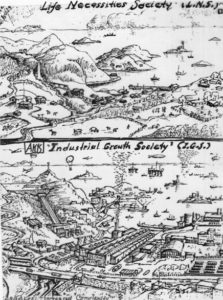
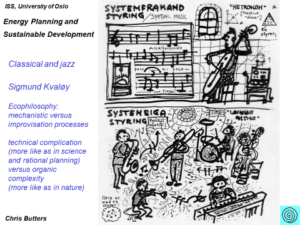
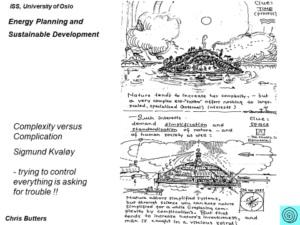
Complexity versus complication; mechanistic thinking; virtual and concrete realities. This kind of thinking is what we need to revisit, reassess, revitalise in new forms.
Another favourite of mine, below, is from the Danish school of thought …
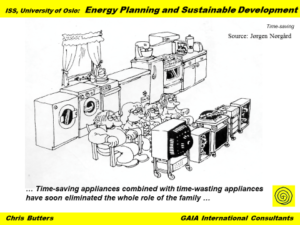
Just a couple of off the top of my head thoughts. On the issue of small v large, the intervening time span since the 70’s has seen huge growth of ‘globalisation’, due arguably to various developments, e.g. IT, containerisation, bulk shipping, and jet aircraft. This might seem to support the notion that technologies do direct the compass. After all the software has to “live” somewhere.
Software and the ideas behind developments are of course immensely important. Globalisation with its promise of “economies of scale”, specialisation, division of labour, would seem to be projecting out to the limit the ideas of Adam Smith. After a fashion they work -at a crude material level, and much of the world has not yet reached the magical $12,000 income level.
But it is important to construct visions beyond this crude materialism, i.e. for “sufficient wealth”. I like the idea of redefining economic values, so that more value is embedded in fewer materials and resources; -so more sophisticated values. However selling this could be problematic as classical liberal economists can always appeal to “poverty consciousness”, by pointing to poorer people, by society as a competitive rat race, by wars and so on.
However, in some respects I think this shift in redefining economic values is beginning to happen -even if contradictorily, e.g. IT, personal devices.
Ok, so these thoughts echo some of the questions you pose. One last thought concerned “the world of desire”. Apparenty it was the Freud family descendants of Sigmund who got a lot of the material consumption economy going in the USA in the ’30’s and ’40’s, with the development of sophisticated advertising, sampling and stats, combined with large technology developments such as white goods, cars. We still have all this.
I think it is the dreams that are projected that have become problematic. The counter dreams and visions still exist too, getting away from it all, self sufficiency, green dreams. Perhaps the polarity is rather artificial. We all live in a mixed world. Maybe the polarity is needed for perception purposes.
On the other hand, I do think certain technologies are inherently suspect, e.g. atomic power (due to excessive power flux densities for the biosphere, excessive hazard, excessive specialisation) and GM which short cuts, (short circuits?) evolution.
